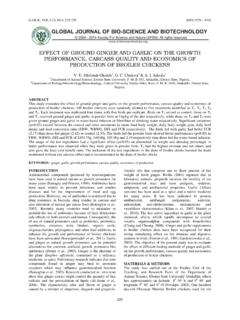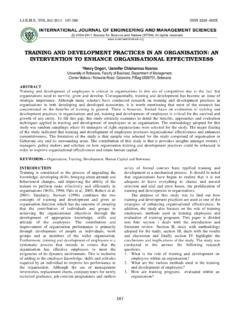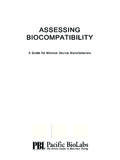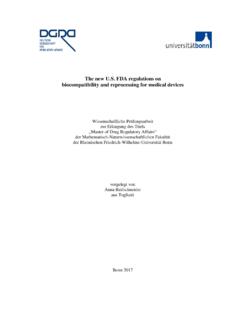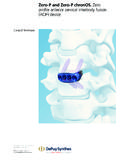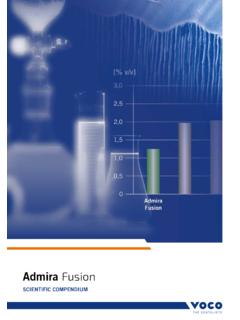Transcription of Short Communication Medical Textiles - Vascular …
1 , (3)2012:557-560 ISSN2250-3579557 Short CommunicationMedical Textiles - Vascular GraftChinta & Textile & Engineering Institute, Ichalkaranji-416115( ), graft supports the patient having cardiovascular problem to continue their normal life. PET and PTFE arechemically stable material after implant when compared with others. PTFE is most successful material for small diametervascular graft. Good handling property of graft includes kink and preclotting resistant during implant and itshould be highresistant to in vivo biodegradation, low thrombogenicity and high breaking : Vascular Graft, Myocardial Infarcts, Biopolymer, Artery, PolydioxanoneINTRODUCTIONA therosclerosis is a coronary heart disease which is one ofthe greatest contributors of cardiovascular disease.
2 Withinthe artery plaque are build up that are made of low densitylipoproteins, fatty acid, collagen, and calcium. Plaquemake the blood vessels rigid, the blood platelets are adherewith the plaque and begins thrombus formation whichcauses the reduction in oxygen and nutrient delivery to theheart muscle and leads heart stroke ( myocardial infarcts). 2220 deaths per million people are caused bycardiovascular disease in 2005 at USA. Treatment afterdiagnosis is essential to replace the diseased arterieshaving blockage with the synthetic one [1]. They aregenerally made (poly-ethylene-teraphthalate)PTFE (poly-tetra-fluroethylene)Many other materials are also utilized but in small quantityand few of them are on experimentation level.
3 Thesematerials are polyurethane, nylon, silicon rubber graft andmore than one polymer Vascular graft structure are alsodeveloped. They are used in the form of woven, knitted,non woven and the effort isgoing on to develop lowdiameter Vascular graft by means of electro spinning :Pictorial view of Vascular graftRequirement of Vascular GraftPorosity, stiffness and type of surface coating are alsosignificant for Vascular graft. The major development inthis area is bioabsorbable material is being used with semi-absorbable structure. The fibers like collagen have anapplication and the future material to coat the graft will beprotein structure as albumin or gelatin.
4 Design Requirements of Graft Desirable biocompatibility. Sufficient viscoelastic properties similar to bloodvessels so that it is sufficiently compliant but willnot allow for over expansion or bursting. Long-term mechanical stability. Prevent graft leakagewhich can lead blood lossand also it should be abrasion , biomaterial surfaces will be morecompatible with the human body if they havesimilar chemistry, morphology and mechanicalproperties to cell surfaces [2].Properties of anideal Vascular graftMedical Textiles - Vascular Graft558 Capable of withstanding long-term hemodynamicstress without failure. Availability, storability, and simplicity ofhandling to minimize operating time, risks, andexpense.
5 Resistance to thrombosis and infection. Complete incorporationby the body to yield aneovessel resembling a native artery in structureand used for the manufacturing of , Dacron Vascular GraftPET is a synthetic fiber made of thermoplastic polymerhave a multiple application from plastic and resin to fiberand now it is completely recyclable. Here the vanderwallforce holds the repeating unit so it can be melted ormoulded with the heat. The aromatic ring contribute tohigh melting point ( Tm 257 C ) , high tensile strength (40to 80 Mpa ), as well as high Young modulus up to 3000 Mpa which higher is than the PTFE and polyurethane, sothe structure made of PET required higher load to 2:Pictorial view of PET structure and weaving of Vascular the Vascular graft application PET is available in theform of knitted and woven with particular coating thatenhance the hydophilicity as well as it is compatible withthe human body have least adherence with the bloodplatelets.
6 Many of the biological components as albuminprotein, or any bioabsorbable can be incorporated topromote the faster healing. It was a past when the integrityof Dacron graft depends on the coating of patient bloodhere the blood fills up the air present in the woven orknitted structure. Now new technology is employed as asealant that seals the graft. In this process the graft surfaceis sealed with the gelatin or albumin coating [3]. PTFEP olytetrafluoroethylene is a fluoro polymer, it has highmolecular weight and hydrophobic in nature as well as it ismaterial has lowest coefficient of friction.
7 Porosity of thegraft is important for the in growth of tissue healingprocess. The porous structure of Vascular graft ismanufacture by the hollow body of PTFE by means ofexpanding of fluoroplastic body. That is characterized bythe microporous node and fibril structure. Another type ofvascular graft is also made by the one or more polymerfiber wound about the mandrel, these fibers are wound insuch a manner that they form a solid structure, and thepores are defined by the adjacent fiber spacing. Differenttypes of fiber combination can used to obtain desiredphysical and chemical property.
8 The disadvantage of thisgraft is larger pore size so it promotes bleeding. Accordingto US a patent the inventor has made the Vascular graftwith two layer of PTFE. They suppose to eliminate thebasic drawback of PTFE graft. The graft includes firstePTFE tubular structure and second structure iscircumferentially disposed about the first structure, theporosity and physical strength of both of layer can bevaried. The first tubular structure provides porosity thatpromotes sufficient indothelization and the second layerexhibit strength vice-versa can also be used to promoterapid tissue incorporation [4].
9 PolydioxanonenPolydioxanone is a polymer of multiple repeating unit ofether and ester unit, and obtained by the ring openingpolymerization. In the form of fiber it is generallyextruded with enough care. Polydioxane has a biomedicalapplication particularly in the form of surgical suturesanother application includes plastic surgery, drug delivery,and promotes tissue ingrowths. Researchers at VirginiaCommonwealth University (VCU), USA, have developeda bio-composite Vascular graft made of Polydioxanone(PDO, a synthetic biodegradable polymer) and Elastin,(natural polymer, which is also a major component of thearterial wall) by means of electrospinning of the material reinforces the graft'smechanical strength, which is critical in order to hold theblood pressure and forces while the regeneration process istaking place.
10 The PDO-Elastin blend undergoes slowdegradation and causes few adverse reactions. Thepurpose of the new material would be tohelp a , (3)2012:557-560 ISSN2250-3579559regenerate a new artery. If it works as designed theresearchers hope that at six months post-surgery, therewould be no more synthetic structure left [5]. Polyurethane Vascular GraftPoly(carbonate) and PTFE Vascular graft have application in largediameter graft. In small diameter (<6mm) the rate offailure is high, this is because the compliance does notmatch with the surrounding host tissue or there may beinability of graft to support endothelial mono layer as wellas PET and PTFE are two to five times stiffer than thenatural arteries.
